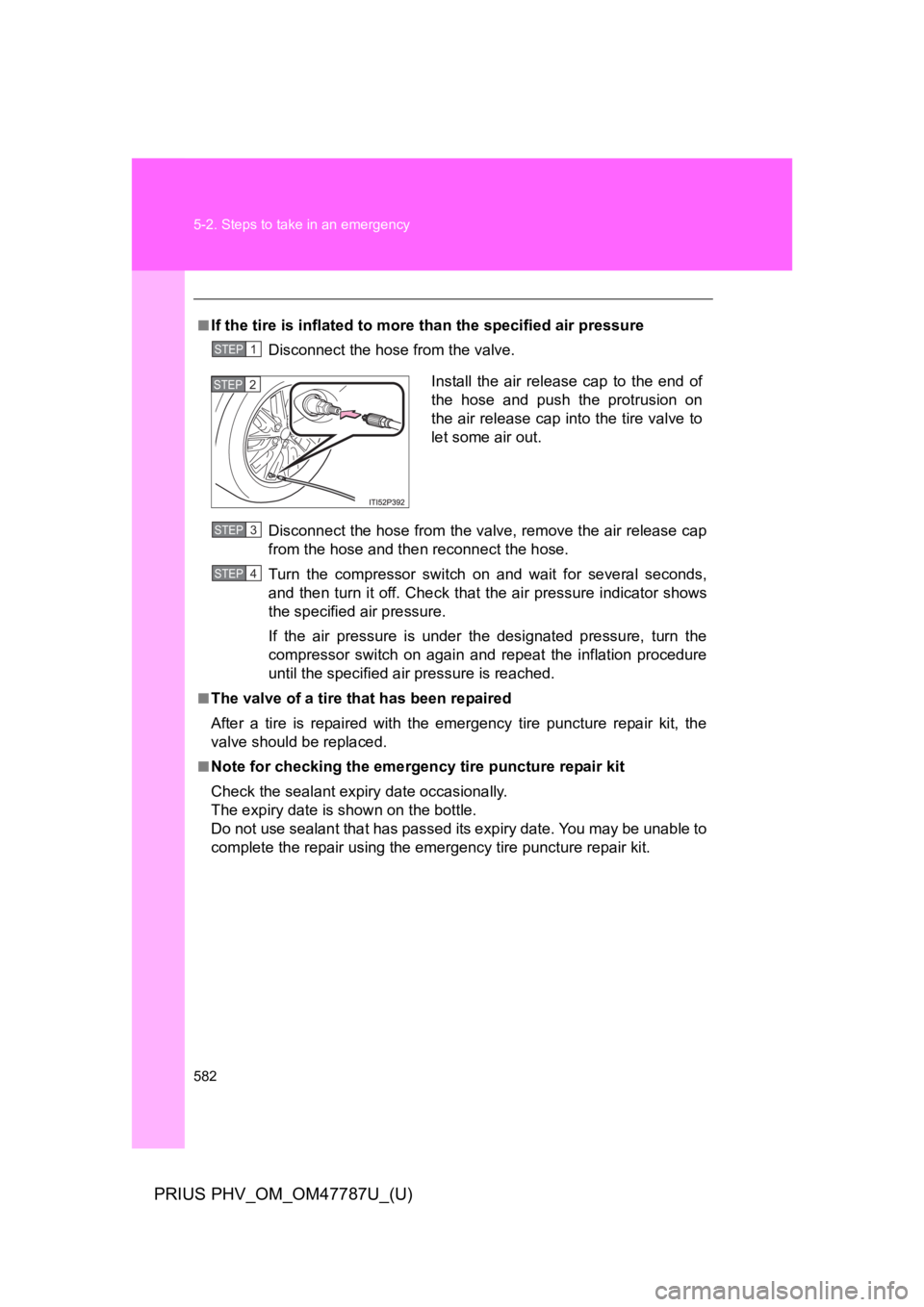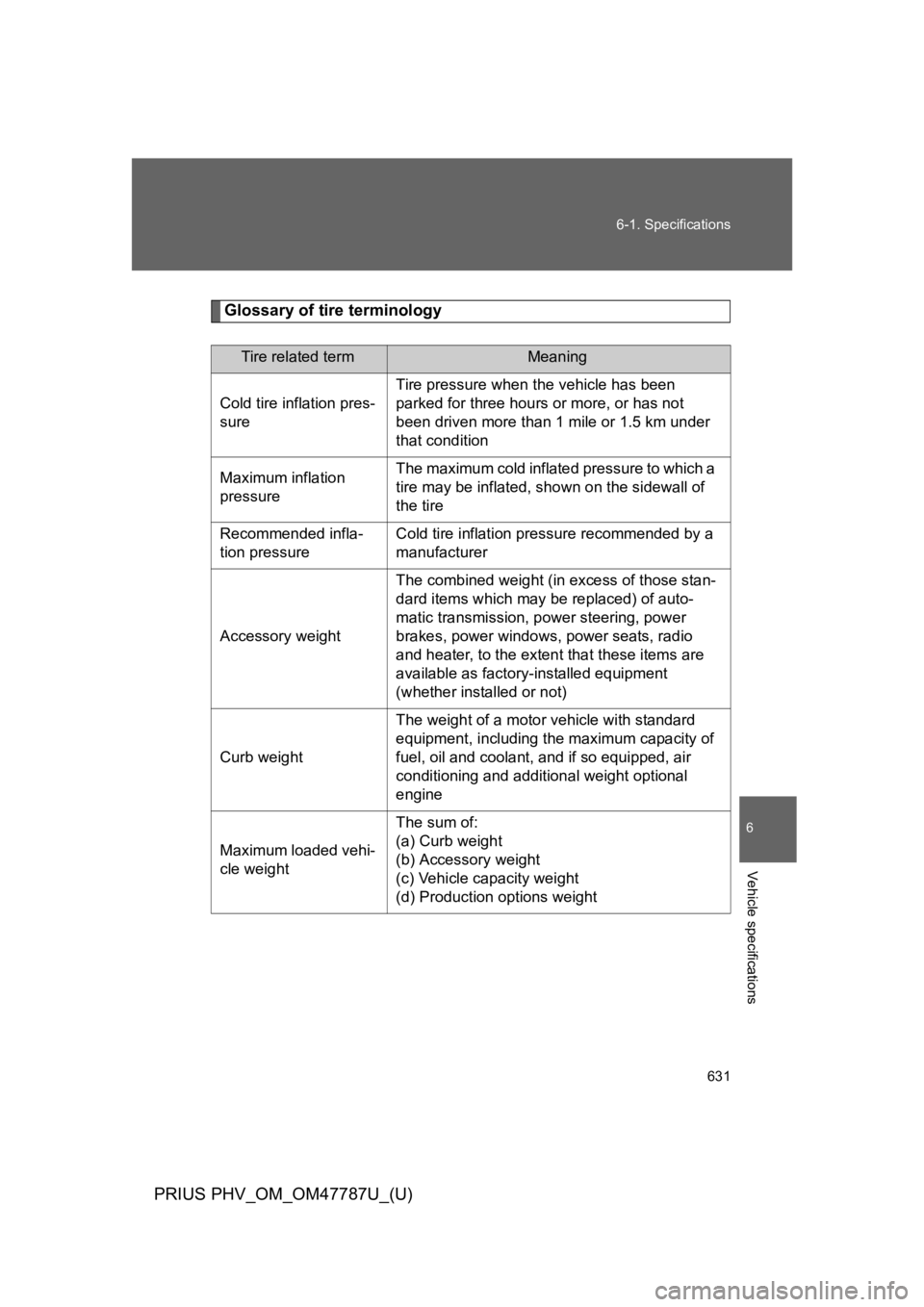Page 601 of 704
578
5-2. Steps to take in an emergency
PRIUS PHV_OM_OM47787U_(U)
•If the tire inflation pressure is
still lower than the specified
point after inflation for 10
minutes (40 minutes at low
temperature) with the switch
on, the tire is too damaged to
be repaired. Turn the com-
pressor switch off and con-
tact your Toyota dealer.
•If the tire inflation pressure
exceeds the specified air
pressure, let out some air to
adjust the tire inflation pres-
sure. (→P. 5 8 2 , 6 1 9 )
With the compressor switch off, disconnect the hose from the
valve on the tire and then pull out the power plug from the
power outlet socket.
Some sealant may leak when the hose is removed.
Install the valve cap onto the valve of the emergency repaired
tire.
STEP14
STEP15
Page 603 of 704
580
5-2. Steps to take in an emergency
PRIUS PHV_OM_OM47787U_(U)
Turn the compressor switch on
and wait for several seconds,
and then turn it off. Check the tire
inflation pressure.
If the tire inflation pressure is
under 19 psi (130 kPa, 1.3 kgf/
cm2 or bar): The puncture
cannot be repaired. Contact
your Toyota dealer.
If the tire inflation pressure is
19 psi (130 kPa, 1.3 kgf/cm2
or bar) or higher, but less than
the specified air pressure:
Proceed to .
If the tire inflation pressure is
the specified air pressure:
Proceed to .
STEP20
STEP21
STEP22
Page 605 of 704

582
5-2. Steps to take in an emergency
PRIUS PHV_OM_OM47787U_(U)
■If the tire is inflated to more than the specified air pressure
Disconnect the hose from the valve.
Disconnect the hose from the valve, remove the air release cap
from the hose and then reconnect the hose.
Turn the compressor switch on and wait for several seconds,
and then turn it off. Check that the air pressure indicator shows
the specified air pressure.
If the air pressure is under the designated pressure, turn the
compressor switch on again and repeat the inflation procedure
until the specified air pressure is reached.
■The valve of a tire that has been repaired
After a tire is repaired with the emergency tire puncture repair kit, the
valve should be replaced.
■Note for checking the emergency tire puncture repair kit
Check the sealant expiry date occasionally.
The expiry date is shown on the bottle.
Do not use sealant that has passed its expiry date. You may be unable to
complete the repair using the emergency tire puncture repair kit.
STEP 1
Install the air release cap to the end of
the hose and push the protrusion on
the air release cap into the tire valve to
let some air out.
STEP 2
STEP 3
STEP 4
Page 608 of 704

5
When trouble arises
585
5-2. Steps to take in an emergency
PRIUS PHV_OM_OM47787U_(U)
CAUTION
■When fixing the flat tire
●Stop your vehicle in a safe and flat area.
●Do not touch the wheels or the area around the brakes immediately
after the vehicle has been driven.
After the vehicle has been driven, the wheels and the area around the
brakes may be extremely hot. Touching these areas with hands, feet or
other body parts may result in burns.
●Connect the valve and hose securely with the tire installed on the vehi-
cle. If the hose is not properly connected to the valve, air leakage may
occur as sealant may be sprayed out.
●If the hose comes off the valve while inflating the tire, there is a risk
that the hose will move abruptly due to air pressure.
●After inflation of the tire has completed, the sealant may splatter when
the hose is disconnected or some air is let out of the tire.
●Follow the operation procedure to repair the tire. If the procedures not
followed, the sealant may spray out.
●Keep back from the tire while it is being repaired, as there is a chance
of it bursting while the repair operation is being performed. If you
notice any cracks or deformation of the tire, turn off the compressor
switch and stop the repair operation immediately.
Page 609 of 704

586
5-2. Steps to take in an emergency
PRIUS PHV_OM_OM47787U_(U)
CAUTION
●The repair kit may overheat if operated for a long period of time. Do not
operate the repair kit continuously for more than 60 minutes.
●Parts of the repair kit become hot during operation. Be careful handling
the repair kit during and after operation. Do not touch the metal part
connecting the bottle and the compressor. It will be extremely hot.
●Do not attach the vehicle speed warning sticker to an area other than
the one indicated. If the sticker is attached to an area where an SRS
airbag is located, such as the pad of the steering wheel, it may prevent
the SRS airbag from operating properly.
■Driving to spread the liquid sealant evenly
Observe the following precautions to reduce the risk of accidents.
Failing to do so may result in a loss of vehicle control and cause death or
serious injury.
●Drive the vehicle carefully at a low speed. Be especially careful when
turning and cornering.
●If the vehicle does not drive straight or you feel a pull through the
steering wheel, stop the vehicle and check the following.
•Tire condition. The tire may have separated from the wheel.
•Tire inflation pressure. If the tire inflation pressure is 19 psi (130
kPa, 1.3 kgf/cm2 or bar) or less, the tire may be severely damaged.
Page 641 of 704
619
6-1. Specifications
6
Vehicle specifications
PRIUS PHV_OM_OM47787U_(U)
Brakes
*1:Minimum pedal clearance when depressed with a force of 44.1 lbf (196 N,
20.0 kgf) while the hybrid system is operating.
*2:Parking brake pedal travel when depressed with a force of 67.5 lbf (300 N,
30.6 kgf).
Steering
Tires and wheels
Pedal clearance*13.03 in. (77 mm) Min.
Pedal free play 0.04 ⎯ 0.24 in. (1.0 ⎯ 6.0 mm)
Brake pad wear limit 0.04 in. (1.0 mm)
Parking brake lining wear limit 0.04 in. (1.0 mm)
Parking brake pedal travel*28 ⎯ 11 c l i c k s
Fluid type SAE J1703 or FMVSS No. 116 DOT 3
Free playLess than 1.2 in. (30 mm)
Tire sizeP195/65R15 89S
Tire inflation pressure
(Recommended cold tire
inflation pressure)
Front tire
35 psi (240 kPa, 2.4 kgf/cm2 or bar)
Rear tire
33 psi (230 kPa, 2.3 kgf/cm2 or bar)
Wheel size 15 × 6J
Wheel nut torque 76 ft•lbf (103 N•m, 10.5 kgf•m)
Page 648 of 704
626
6-1. Specifications
PRIUS PHV_OM_OM47787U_(U)
Ty p i c a l D O T a n d T i r e I d e n t i f i c a t i o n N u m b e r ( T I N )
DOT symbol*
Tire Identification Number
(TIN)
Tire manufacturer ’s identifica-
tion mark
Tire size code
Manufacturer’s optional tire
type code (3 or 4 letters)
Manufacturing week
Manufacturing year
*:The DOT symbol certifies
that the tire conforms to
applicable Federal Motor
Ve h i c l e S a f e t y Sta n d a r d s .
Load limit at maximum cold tire inflation pressure (→P. 4 8 1 )
Maximum cold tire inflation pressure (→P. 6 1 9 )
This means the pressure to which a tire may be inflated.
Uniform tire quality grading
For details, see “Uniform Tire Quality Grading” that follows.
Page 653 of 704

631
6-1. Specifications
6
Vehicle specifications
PRIUS PHV_OM_OM47787U_(U)
Glossary of tire terminology
Tire related termMeaning
Cold tire inflation pres-
sure
Tire pressure when the vehicle has been
parked for three hours or more, or has not
been driven more than 1 mile or 1.5 km under
that condition
Maximum inflation
pressure
The maximum cold inflated pressure to which a
tire may be inflated, shown on the sidewall of
the tire
Recommended infla-
tion pressure
Cold tire inflation pressure recommended by a
manufacturer
Accessory weight
The combined weight (in excess of those stan-
dard items which may be replaced) of auto-
matic transmission, power steering, power
brakes, power windows, power seats, radio
and heater, to the extent that these items are
available as factory-installed equipment
(whether installed or not)
Curb weight
The weight of a motor vehicle with standard
equipment, including the maximum capacity of
fuel, oil and coolant, and if so equipped, air
conditioning and additional weight optional
engine
Maximum loaded vehi-
cle weight
The sum of:
(a) Curb weight
(b) Accessory weight
(c) Vehicle capacity weight
(d) Production options weight